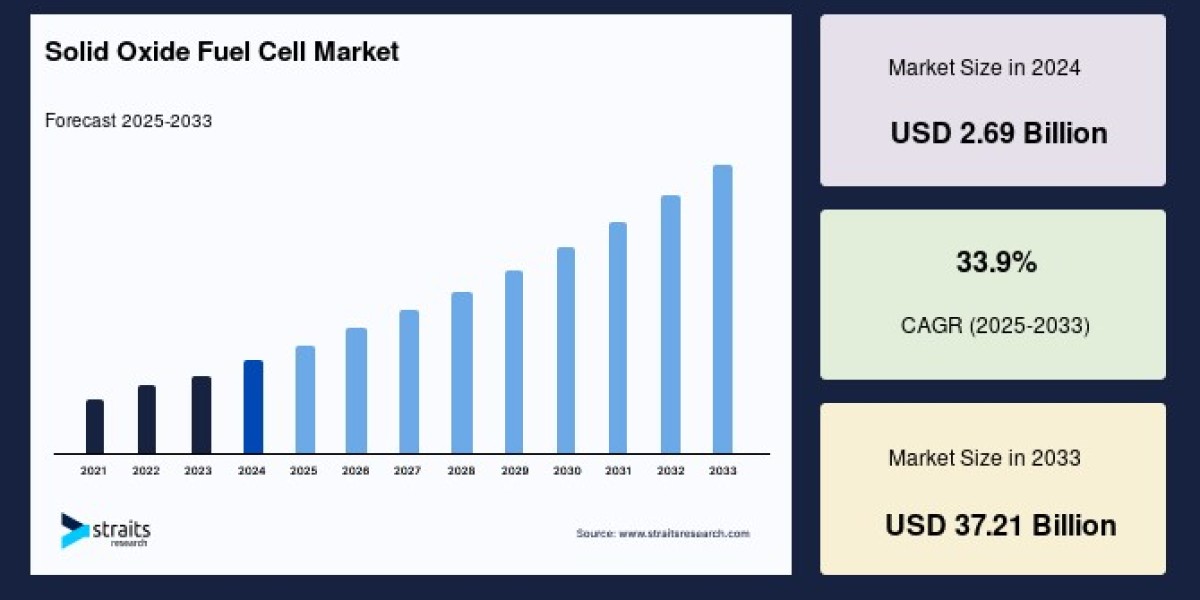Introduction
Solid oxide fuel cells (SOFCs) are at the forefront of the energy revolution, offering eco-friendly and versatile solutions for stationary and mobile power generation. These fuel cells directly convert chemical energy into electricity by oxidizing fuels such as hydrogen and natural gas, emitting minimal pollutants. Their nontoxic by-products and quiet operation make them a promising alternative for reducing environmental impact and noise pollution in various applications.
Market Overview and Growth Dynamics
The global solid oxide fuel cell market size was valued at USD 2.69 billion in 2024 and is estimated to reach from USD 3.60 billion in 2025 to USD 37.21 billion by 2033, growing at a CAGR of 33.9% during the forecast period (2025–2033).
Innovation and Public-Private Collaboration
Technological development in the SOFC industry is greatly influenced by strategic alliances between private enterprises and government bodies. Funding from organizations like the U.S. Department of Energy (DOE) supports research, cost optimization, and market expansion. These collaborations expedite the evolution of high-efficiency fuel cells at economically viable prices, paving the way for broader adoption in power generation, transportation, and military applications. Legislative efforts, comprehensive policies, and regulatory support in key regions provide a fertile environment for market growth.
Regional Analysis
Asia-Pacific
Asia-Pacific stands as the largest SOFC market, especially dominated by Japan and South Korea. Favorable policies have led to widespread adoption, while government agencies and research institutes actively promote operational reliability studies. In countries like India, Thailand, and Singapore, evolving regulations are expected to drive alternative energy sector growth, propelling the SOFC market further.
Europe
Europe is projected to be the fastest-growing SOFC market, exhibiting a remarkable CAGR of 46.9%. Germany leads the region with its definitive energy policy and clearly defined carbon-neutrality targets. National research and development programs, supported by dedicated authorities, accelerate technological innovation and reduce commercialization timelines. Ambitious plans to achieve carbon neutrality by 2025 and transformation roadmaps extending to 2050 underscore Europe’s commitment to sustainable energy.
North America
North America remains a pivotal SOFC market, with the United States monopolizing regional growth due to favorable regulations, incentives, and federal funding. The DOE’s research initiatives and grant programs accelerate market uptake, particularly in states such as California and Connecticut. Bloom Energy and other market leaders are expanding large-scale SOFC installations, emphasizing decentralized power generation and reliable electricity supply.
Application Segmentation: Stationary, Transportation, and Portable
The SOFC market is segmented by application into stationary, transportation, and portable power solutions. The stationary segment holds the largest market share and is expected to achieve a CAGR of 42.0%. This segment encompasses applications in data centers, residential, commercial, industrial, and military sectors. Stationary SOFC systems are celebrated for their clean, efficient, and robust heat and power generation capabilities, outperforming many conventional technologies. Cogeneration systems that harness waste heat for electricity or steam production further augment their appeal.
Data Centers and Industrial Demand
Data centers have emerged as one of the fastest-expanding end-users for stationary SOFC applications, particularly in the US. The sector’s high power demands and need for uninterrupted energy supply drive the adoption of distributed generation solutions, with leading companies like Google, IBM, and Equinix integrating SOFC systems. The growing opportunities in military and industrial sectors bolster market prospects.
Residential and Commercial Opportunities
Strong legislative support and incentive programs in countries such as Germany, Japan, and South Korea are encouraging the deployment of SOFC systems in residential settings. Japan’s Ene farm program, for instance, has accelerated fuel cell micro-cogeneration adoption. In Europe, significant funding for transport and energy production research further underlines the segment’s growth potential.
Challenges and Barriers
Despite robust market expansion, high system costs and efficiency challenges remain the primary obstacles for wider SOFC adoption. Compared to other fuel cell technologies such as PEMFC and solar PV, SOFC systems have higher capital costs, especially in stationary power generation. The economic viability of fuel cell-powered vehicles is also impacted by inefficient hydrogen production and lower vehicle efficiency relative to battery-operated electric vehicles. Industry participants are consequently focusing on technology packaging and scale economies to lower costs and extend product lifecycles. Advancing policies that help manufacturers achieve these efficiencies will be crucial for overcoming market hurdles.
Outlook and Future Potential
As the global push for zero-emission technologies intensifies, SOFCs are poised to play an increasingly significant role in addressing environmental and energy challenges. Their flexibility, minimal emissions, and integrated waste heat recovery capabilities position them as a cornerstone of future power generation. Continued support from regulators, industry leaders, and collaborative research will be vital in realizing the solid oxide fuel cell market’s full potential.
Conclusion
The solid oxide fuel cell market is on the cusp of transformative growth, driven by innovation, regulatory support, and increasing demand for clean, reliable energy. With broad applications spanning data centers, commercial buildings, homes, military, and transportation, SOFC technologies stand to shape the future of sustainable power generation around the world.













